Working professionals
Fresh graduates
- Study abroad
- Offline centres
More
14. Radix Sort
20. AVL Tree
21. Red-Black Tree
23. Expression Tree
24. Adjacency Matrix
36. Greedy Algorithm
42. Tower of Hanoi
43. Stack vs Heap
47. Fibonacci Heap
49. Sparse Matrix
50. Splay Tree
Understanding Spanning Trees in Data Structures: A Detailed Guide
Introduction
A spanning tree is one of the most important concepts in data structures. In data structures, a spanning tree is a subset of a larger graph, ensuring that every vertex is linked together with the minimum number of edges required.
Spanning trees have a rich history dating back to the early developments in graph theory. Mathematicians such as Gustav Kirchhoff and Leonhard Euler pioneered this idea in the mid-20th century. Spanning trees have gained immense importance in computer science and network engineering.
Over the years, the relevance of spanning trees has grown exponentially. Due to increasing data connectivity across networks, spanning trees have played a crucial role in optimizing network designs, guaranteeing efficient communication paths, and enabling fast data transfer.
This guide will discuss spanning trees with respect to data structures. It will outline their basic characteristics, provide some practical examples, and more.
Overview
A spanning tree in data structure acts as a guiding framework within an undirected connected graph. It's like a map that includes all the essential locations while minimizing the connections needed. It's no longer considered a spanning tree if any point is left out.
It is a tree that spans all the vertices of a given graph; it is loop-less and enables reaching all its points, thereby becoming an important tool for different needs.
What is a Spanning Tree?
A spanning tree is a subset of a connected undirected graph that efficiently covers all its vertices with the minimum possible number of edges. It is the backbone of the original graph, ensuring that every vertex is reached without any redundancy.
A spanning tree in data structures is a tool in graph theory that paves the way for efficient solutions to various problems across various domains. Domains like image processing, network design, and so on all use the concept of spanning trees.
Now, how many edges does a spanning tree typically have?
A spanning tree consists of n−1 edges, with 'n' representing the total number of vertices (or nodes) in the graph.
These edges may or may not be assigned weights. Interestingly, regardless of the complexity of the original graph, all resulting spanning trees will maintain the same number of vertices. The spanning tree, on the other hand, always has one fewer edge than the original graph's vertices.
Let's consider a simple graph with 4 vertices (A, B, C, D) and 4 edges connecting them:
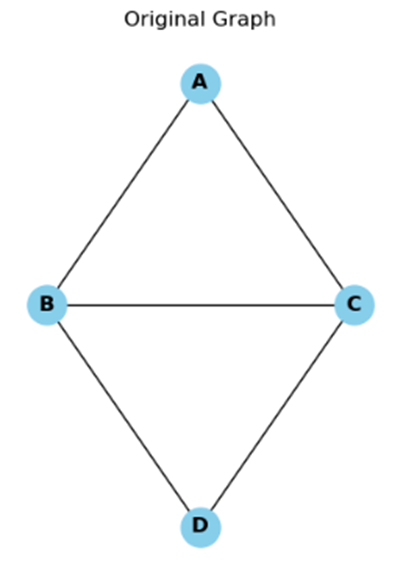
Let's now search for a spanning tree in this graph. We need to connect all vertices with the minimum number of edges possible and ensure that the resulting structure doesn't contain any cycles.
One possible spanning tree for this graph would be:
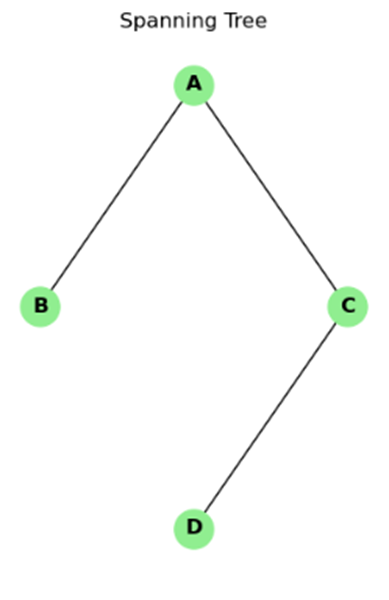
In this spanning tree, we've connected all the vertices (A, B, C, D) with just 3 edges (AB, AC, CD), covering the entire graph without forming any cycles. This meets the criteria of a spanning tree: it's connected and acyclic.
Now, let's talk about the broader context of graphs.
Graphs
Graphs, as you might already know, are composed of vertices and edges. But did you know that there are different types of graphs? There are two main types:
You've got your directed graphs, often called digraphs, where edges come with defined directions, dictating the flow of connectivity between vertices.
On the flip side, undirected graphs don't go over directions—they simply establish connections between vertices without any bias. Then, there are connected graphs, where every vertex is seamlessly linked to every other vertex—a cohesive network of interconnectedness.
So, what sets a spanning tree apart from a graph?:
- The absence of cycles
- The optimal use of edges.
While a graph might twist and turn, looping back on itself in a convoluted maze of connections, a spanning tree in data structure maintains a simple, elegant structure—no loops, no redundancy, just the bare essentials needed to cover every vertex in the graph.
Properties of Spanning Tree in Data Structures
Here are some properties of spanning trees in data structures you should know;
1. Absence of Loops or Cycles
One defining characteristic of a spanning tree in data structures is its acyclic nature. Unlike their parent graphs, spanning trees steer clear of loops or cycles. This property ensures that each vertex is reached via a single, unambiguous path, contributing to the tree's simplicity and efficiency.
2. Vertex and Edge Count
A spanning tree comprises 'n' vertices and 'n-1' edges—a balanced ratio that optimally connects all vertices while minimizing redundancy. This consistent structure holds true across all spanning trees derived from a given graph, providing a clear framework for exploration and analysis.
3. Equivalent Vertices
Regardless of the specific configuration of edges, every spanning tree in data structures maintains the same set of vertices as its parent graph—a testament to the inherent connectivity preserved within these structures.
Minimal Connectedness
The minimal connectedness of spanning trees underscores their essential role in maintaining graph connectivity. Removing even a single edge from a spanning tree can disrupt this delicate balance, rendering the graph disconnected and disrupting the flow of information or resources.
4. Vulnerability to Loops
While spanning trees excel at maintaining acyclic pathways, they're susceptible to the introduction of loops or cycles. Adding an edge to a spanning tree can inadvertently create such cycles, altering its structure and potentially affecting its functionality.
5. Connectivity Requirement
Spanning trees thrive in the world of connected graphs, where every vertex is seamlessly linked to its counterparts.
Relationship Between Spanning Trees and Minimum Spanning Trees
A Minimum Spanning Tree (MST) is an important type of spanning tree. While spanning trees in general, aim to cover all vertices of a graph with the minimum possible number of edges and without any cycles, a Minimum Spanning Tree goes a step further.
In addition to meeting the criteria of a spanning tree, an MST specifically focuses on minimizing the total weight or cost of the edges that connect all vertices. This means that among all possible spanning trees of a graph, a Minimum Spanning Tree is the one with the lowest total edge weight.
Here is a comparison;
Aspect | Spanning Trees | Minimum Spanning Trees (MSTs) |
Definition | Subgraph of a connected graph covering all vertices with the minimum number of edges | Subset of edges from a connected weighted graph that connects all vertices with the minimum possible total edge weight |
Objective | Ensure connectivity and coverage of all vertices with the minimum possible number of edges | Achieve connectivity while minimizing the total edge weight |
Edge Weight | May or may not have weights assigned to edges | Each edge has a weight representing the cost or distance between vertices |
Number of Edges | n−1 (where n is the number of vertices) | n−1 (for a connected graph with n vertices) |
Application | Essential in various graph-related algorithms, network design, and topology analysis | Widely used in optimization problems such as network routing, clustering, and facility location |
What are Minimum Spanning Trees?
A Minimum Spanning Tree (MST) is essentially a spanning tree within a graph where the total weight of the edges is minimized. In other words, it's the most efficient way to connect all the vertices while keeping the cumulative weight as low as possible. This weight can signify various real-world metrics such as distance, traffic load, congestion, or any other relevant factor.
Finding a minimum spanning tree in data structure typically involves employing specialized algorithms such as Prim's Algorithm or Kruskal's Algorithm. These algorithms systematically evaluate the weights of edges and iteratively select the most favorable ones to construct the MST.
Now let me explain the minimum spanning tree in data structure with examples
Let's consider a simple scenario where we have a set of points in a two-dimensional plane, and we want to connect them with the minimum total length of line segments. Here's the graph representing the points and the distances between them:
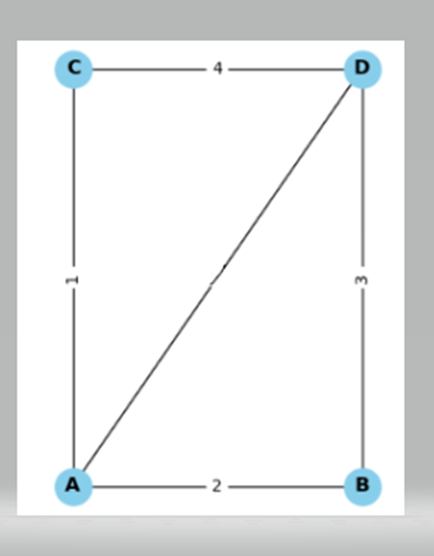
In this graph:
- A, B, C, and D represent points in the plane.
- The numbers on the edges represent the lengths of line segments connecting the points.
Now, let's find the Minimum Spanning Tree (MST) for this graph. The MST will represent the shortest possible way to connect all the points:
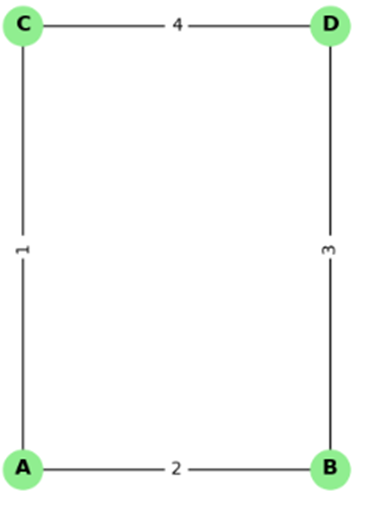
In this Minimum Spanning Tree:
- We've connected all the points with the least total length of line segments.
- Each point is reachable from every other point via the MST.
- The total length of line segments in this MST is minimized, ensuring efficient connectivity between the points.
Algorithms for Determining a Graph's Minimum Spanning Tree
When it comes to uncovering the most efficient way to connect vertices within a graph while minimizing total edge weights, several algorithms step up to the plate. Here's a glimpse into some of these algorithms:
1. Kruskal’s MST Algorithm
Kruskal’s Minimum Spanning Tree (MST) algorithm operates on the principle of greediness—aiming to build a spanning tree by consistently selecting the edges with the lowest weights. The goal is to establish connectivity among all vertices while steering clear of cycles.
Algorithm:
- Initially, the algorithm sorts all edges of the graph based on their weights.
- It iterates through these edges, gradually adding the lowest-weight edge to the spanning tree, ensuring it doesn’t create cycles in the process.
- This algorithm efficiently leverages a Disjoint-Set data structure to keep track of connected components, enabling its widespread application in network design, clustering, and data analysis tasks.
Pseudocode:
KRUSKAL(G):
A = ∅
For each vertex v ∈ G.V:
MAKE-SET(v)
For each edge (u, v) ∈ G.E sorted in ascending order by weight(u, v):
if FIND-SET(u) ≠ FIND-SET(v):
A = A ∪ {(u, v)}
UNION(u, v)
return A
Let’s say you're tasked with constructing roads to connect several cities in a region, each represented as vertices in a graph.
The edges between cities represent potential road segments, with their weights indicating construction costs. Using Kruskal's algorithm, you can efficiently identify the sequence of road segments to build, ensuring connectivity among all cities while minimizing construction expenses.
2. Prim’s Minimum Spanning Tree
Prim's algorithm is another important minimum spanning tree algorithm in data structure. It adopts a similar greedy approach. Starting with an empty spanning tree, it systematically selects edges that minimize the total weight while ensuring connectivity among all vertices.
Algorithm:
- The algorithm kicks off by arbitrarily selecting a vertex and incorporating it into the MST.
- It then scours the graph for the minimum-weight edge that links a vertex within the MST to one outside it.
- This process persists until all vertices find their place within the MST.
This algorithm operates by dividing the vertices into two sets: U and V-U. U comprises the visited vertices, while V-U consists of those yet to be explored. Iteratively, the algorithm selects the edge with the lowest weight connecting a vertex from U to one in V-U.
Pseudocode
Set T as an empty set;
Set U as a set containing only vertex 1;
while (U is not equal to all vertices V)
Let (u, v) be the lowest cost edge such that u is in U and v is in V - U;
Add edge (u, v) to T;
Add vertex v to U;
Prim's algorithm often employs priority queues to efficiently identify the minimum weight edge at each step. This facilitates seamless sorting of vertices based on their edge weights. It's a go-to tool for scenarios like image segmentation and routing optimization, offering solutions tailored to diverse problem sets.
Let's consider a simpler example involving a graph representing a set of points in a two-dimensional plane. We'll use Prim's algorithm to find the Minimum Spanning Tree (MST) for this graph.
Let’s say you have a set of points scattered across a 2D plane, each representing a location of interest. Your task is to connect these points with the shortest total length of line segments while ensuring that all points remain connected. Using Prim's algorithm, you can efficiently identify the sequence of line segments to draw, creating the most efficient network of connections.
For instance, let's say we have the following graph representing the points and the distances between them:
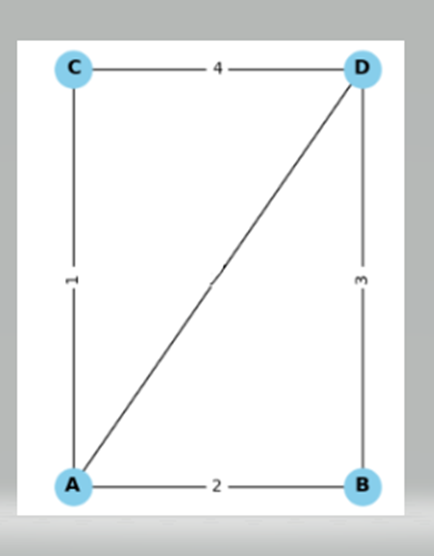
In this graph:
- A, B, C, and D represent points in the plane.
- The numbers on the edges represent the lengths of line segments connecting the points.
When you apply Prim's algorithm, you can systematically select the shortest line segments to connect the points, ensuring that all points are reachable from one another. The resulting Minimum Spanning Tree (MST) will represent the most efficient way to establish connectivity while minimizing the total length of line segments required.
3. Boruvka’s Algorithm
Boruvka’s Algorithm stands as one of the earliest methods for uncovering the Minimum Spanning Tree (MST) of a connected, undirected graph. This algorithm operates by systematically constructing the MST, initially treating each vertex in the graph as its own separate tree.
Algorithm:
- It commences by initializing a forest of trees, with each vertex as a standalone tree.
- In each iteration, the algorithm identifies the cheapest edge that connects one tree to another.
- These edges are then added to the MST, effectively merging the connected trees.
- This process continues until the forest condenses into a single tree—the Minimum Spanning Tree.
While Boruvka’s Algorithm is relatively straightforward to implement and comprehend, it may not offer the same efficiency as other algorithms, particularly for larger graphs with numerous edges.
For example, let’s say you are tasked with designing an efficient network of roads to connect several cities in a region.
Each city is represented as a vertex in the graph, and the edges denote potential road segments with associated costs. Boruvka’s Algorithm comes into play by systematically identifying the cheapest connections between cities, gradually building the Minimum Spanning Tree (MST) of the road network.
4. Reverse-Delete Algorithm
The Reverse-Delete Algorithm resembles Kruskal’s Algorithm, albeit with a reversed approach to edge selection. The Reverse-Delete Algorithm chooses a decreasing order, whereas Kruskal's Algorithm prioritizes edges by increasing weight.
Algorithm:
- Sort each edge in the graph according to its weights in a non-increasing order.
- Begin with the original graph as the Minimum Spanning Tree (MST), and progressively remove excess edges.
- Iteratively select the highest-weighted edge from the remaining set and assess whether its removal disconnects the graph.
- If the removal maintains connectivity, the edge is deleted from the MST; otherwise, it's retained.
- This process continues until the optimal Minimum Spanning Tree is achieved.
Consider a scenario where you need to optimize the layout of a utility grid to supply electricity to various neighborhoods in a city efficiently.
Each neighborhood corresponds to a vertex in the graph, and the edges represent potential power lines with installation costs. Utilizing the Reverse-Delete Algorithm, you can systematically evaluate and remove redundant or costly power lines while maintaining neighborhood connectivity.
Real-World Applications of a Spanning Tree:
Pathfinding: Spanning trees are integral to pathfinding algorithms like Dijkstra’s and A*. These algorithms power navigation systems and logistics, efficiently finding optimal routes between locations.
Telecommunication: In telecommunication networks, spanning trees establish reliable connections between nodes, ensuring redundancy and fault tolerance for robust communication.
Image Processing: Spanning trees aid image segmentation, breaking images into regions based on intensity or color. This assists in object recognition and classification in image processing tasks.
Social Network Analysis: Spanning trees help identify crucial connections and relationships in social networks, providing insights into social structures and interactions.
Electronic Circuit Design: In electronic circuit and PCB layout design, spanning trees optimize wiring layouts, reducing signal interference and enhancing the efficiency and reliability of electronic systems.
Conclusion
In conclusion, spanning trees are fundamental data structure and graph theory concepts with wide-ranging practical uses. They optimize network designs, ensuring efficient communication and data transfer. Their applications extend to diverse fields like image processing, social network analysis, and electronic circuit design, highlighting their versatility.
When you understand their properties, algorithms, and real-world applications, this provides valuable insights for problem-solving.
There is no doubt that spanning trees offer a structured approach to address various challenges in modern infrastructure, making them indispensable tools in today's digital landscape.
FAQs
1. Why is it called a spanning tree?
It's called a spanning tree because it's a tree-like structure that spans or covers all the vertices of a graph without forming any cycles. What is the formula for a spanning tree?
2. What is the formula for a spanning tree?
There isn't a specific formula for a spanning tree. However, the number of edges in a spanning tree with 'n' vertices is generally 'n-1'. What is an example of a Minimum Spanning Tree (MST)?
3. What is an example of a Minimum Spanning Tree (MST)?
A classic example of an MST is a network of cities connected by roads, where the MST represents the most efficient set of roads that connect all the cities while minimizing total distance or cost. What are Kruskal's and Prim's algorithms?
4. What are Kruskal's and Prim's algorithms?
Kruskal's and Prim's algorithms are two popular methods for finding Minimum Spanning Trees (MSTs) in a graph. They both aim to connect all vertices of the graph with the minimum possible total edge weight. What is a spanning tree?
5. What is a spanning tree?
A spanning tree is a subgraph of a connected graph that includes all the vertices of the graph with the minimum possible number of edges, ensuring connectivity without forming any cycles. What is meant by a spanning tree?
6. What is meant by a spanning tree?
A spanning tree refers to a tree-like subgraph of a larger graph that covers or spans all the vertices of the graph without forming any cycles. It serves as a connected and acyclic framework within the original graph.

Author|417 articles published


upGrad Learner Support
Talk to our experts. We are available 7 days a week, 10 AM to 7 PM
Indian Nationals
Foreign Nationals
Disclaimer
The above statistics depend on various factors and individual results may vary. Past performance is no guarantee of future results.
The student assumes full responsibility for all expenses associated with visas, travel, & related costs. upGrad does not .






















-7f4b4f34e09d42bfa73b58f4a230cffa.webp&w=128&q=75)
-ae8d039bbd2a41318308f8d26b52ac8f.svg)



